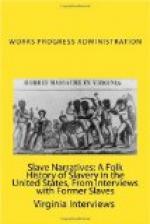Clark County did not have an auction block or slave market but every New Years day in front of the Courthouse owners would bring their slaves to be hired. It was told by one of the old citizens a few years ago, (died two years ago) that he walked nine miles one bitter cold day to hire some slaves. These could be hired for a definite time or until they brought certain amounts of money.
In 1812-1814 Winchester, the County Seat of Clark County boasted of a weekly newspaper, issued every Saturday. From the advertisement column of this paper we learned that Dillard Collins was willing to pay $10.00 to get his run away slave, Reuben, and a similar reward was offered for one “Scipio” who had taken French leave from his master, (donned) in his master’s new clothes. Another ad in this paper ways[TR: says?] one Walter Karrick offered to trade a negro woman for “whiskey”, cyder and flour.
“A story is told of a slave “Monk Estill” who helped or rather belonged to Col. James Estill of Madison County. In 1782 in a battle known as Estill’s defeat, which occured on the grounds where Mt. Sterling now stands in Montgomery County, Col. Estill and twenty-five men attacked a party of Wyandotte Indians by whom the slave was taken prisoner.
“In the thickest of the fight, Monk called out in a loud voice; ’Don’t give way, Marse Jim, there’s only twenty-five Indians and you con whip all of them.’
“Col. Estill was killed and the men retreated. Monk escaped from his captors and after many hardships joined the white comrades.
“On his shoulder he carried a wounded soldier twenty-five miles to Estill Station. His young master gave him his freedom in recognition for his bravery and supported him in comfort the rest of his life.”
In Clark County are many small negroe settlements formed by the old freed slaves after the war. Some had accumalated a little and brought a small piece of land and others had homes given to them by their owners.
Mr. Archilles Eubank was the largest slave holder of his day, Mr. Colby Quisenberry was second, in Clarks County.
“The story is told that at the time of General Morgan’s last raid on Winchester, an old faithful slave of Dr. Hubbard Taylor, (a noted Physician all over this portion of Kentucky at this time) who was always careful of his master’s interests, and without the consent of his master, saved his very fine riding horse, “Black Prince” from being pressed into service of the Confederates. Ab (the slaves name) learned that Morgan’s men were good judges of horse flesh and had taken several horses just as the Federals did when they needed them and he determined to conceal prince, whose groom he was. He put him there in the smoke house along with the meat, but Prince pawed and made disturbances until he took him out and took him to the cellar persuading him to descend the steps and left him there. He came up to hear that several horses had been taken




